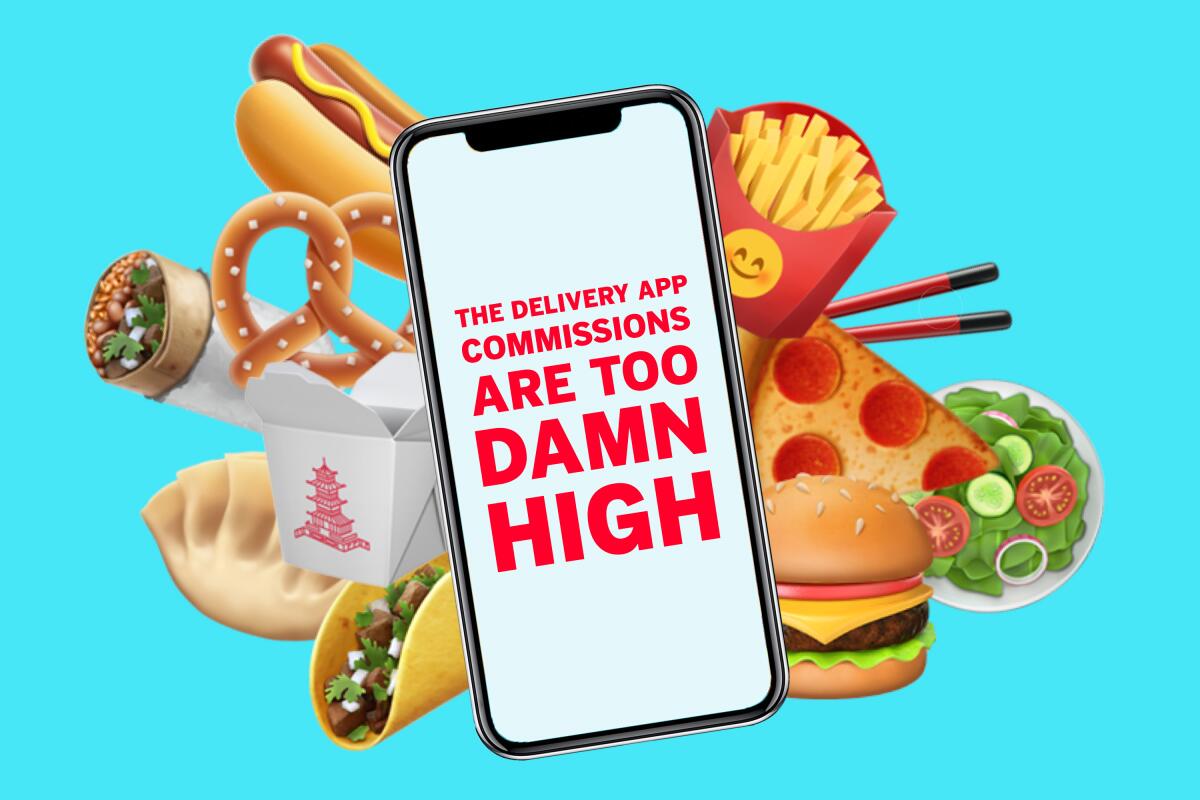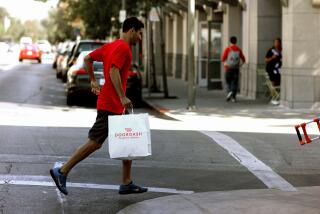Column: Our restaurants are failing. Why should food delivery apps thrive?

It was the invoice from hell.
Many of us saw the viral social media post from a couple of weeks ago, when Chicago restaurant owner Giuseppe Badalamenti posted his March invoice from food delivery app Grubhub. After being docked for commissions, fees, adjustments and promotions, all that remained of his pizza joint’s $1,042.63 in pickup and delivery sales: a measly $376.54.
Badalamenti’s example, while extreme, sheds light on what is becoming an increasingly onerous problem for restaurants as we enter the third month of the coronavirus shutdown: crushing delivery app fees that can hover around 30% of the total cost of an order.
Leveling such steep commissions on an industry with notoriously thin profit margins does not help restaurants in the best of times. During a pandemic, it is hastening their demise.
Los Angeles must follow examples set by San Francisco and New York by setting caps on the commissions that delivery apps can collect from restaurants until they are able to resume full dine-in service. It should also adopt similar legislation to that passed in Chicago, which requires the delivery apps to present a clear and transparent breakdown of fees to diners.
At the very least, delivery apps should be forced to cap their fees on small, independent restaurants and chains. Ordering from McDonald’s or Taco Bell? Sure, charge them the full amount.
My capitalist brain works as well as anyone’s, and I get that delivery apps are businesses with money of their own to make, investors to answer to and employees to pay. But services like Uber Eats and Grubhub are serving a record number of customers during a time when many struggling restaurants are seeing barely any.
Restaurants have little recourse but to play ball: Tapping on a smartphone to order dinner is easy, and many diners don’t feel comfortable leaving their homes to pick up food right now. Most restaurants, meanwhile, don’t have their own drivers in house: Besides the cost to employ them, it’s also a legal headache. (App delivery workers have their own problems — they’re struggling to make a living wage while trying to keep safe during the pandemic.)
Before the shutdown, Anca Caliman, co-owner of Lemon Poppy Kitchen in Glassell Park and Parsnip in Highland Park, said that less than 15% of her restaurants’ revenue came through apps. Now it’s more than half, which means her profit margins are thinner.
Caliman called dealing with the delivery apps a “necessary evil.”
“Even before the madness, it was just a terrible deal no matter how you slice it,” she said. “The fees are just too high. Restaurant profit margins are maybe 5% on average.
“Then to have a delivery service charge between 20% and 30% is just crazy. And the way they present themselves: ‘You’re going to get so many more orders.’ 1,000 orders at 30% off does not help.”
Lack of transparency in the fee structure is an additional frustration. Caliman said that when she first spoke to Grubhub two years ago, she was quoted a 10% fee. “When you talk to a salesperson on the phone, they promise you everything,” she said.
She estimated the actual amount she pays on Grubhub orders is between 25% and 27%.
“Nothing that they do seems like it’s in the best interest of their customers.”
Caliman wants to ditch Grubhub but feels pressure to maintain a presence on the apps, despite the way their fees can often eliminate her chance of making any money on what she’s selling.
Matt Giamela, owner of Giamela’s in Atwater Village and RC Provisions, echoed that feeling.
“You have to go along with it because everyone else is doing it, and you don’t want to inflate your prices,” said Giamela, who pays Uber Eats a 22% commission.
The rates restaurants pay are not uniform across the board. They can vary wildly from platform to platform and business to business. Those who do a high volume of orders, or agree to be exclusive with one partner, can sometimes negotiate a lower rate.
Apps like Uber Eats will offer to let restaurants make up fees by increasing their prices, he said, “but you don’t do it because customers won’t come if you’re two or three dollars more than your competition.”
“It eats away at the bottom line,” he said.
Last year, DoorDash acquired Caviar for $410 million. Now the pool is set to consolidate yet further. Uber — which in the past has been accused of deceptive business practices — is in talks to purchase Grubhub for about $6 billion. That could give Uber even greater leverage to slap whatever fees it chooses onto deliveries.
While neither Uber nor Grubhub turns a profit delivering food, they are nonetheless venture-backed and raking in mountains of cash: Grubhub reported revenue of $362.98 million during the first quarter this year, a year-over-year increase of more than 12%. Uber Eats’ revenue surged 53% from the same quarter a year ago, to $819 million.
Restaurants, meanwhile, are facing utter devastation. The restaurant industry lost 5.5 million jobs nationwide in April, according to the Bureau of Labor Statistics. In L.A., the overall unemployment rate now stands at 24%, an increase from 4.7% in February.
One Hollywood restaurant owner, who shared details of her restaurant’s finances on the condition she not be identified, let me see her Grubhub invoice for March, which showed 93 orders totaling $6,626 in revenue. Grubhub took $1,208 in commission, $592 in a separate delivery fee, and $230 in processing fees for a total of $2,030, just over 30%. That left $4,596 — which included $573 in sales tax that she’s responsible for paying.
“It’s unfair,” she said. “But what can I do?” She said she’s racking up credit card debt and struggling to bring in enough money to pay her bills and 13 remaining employees. “Everyone’s scared. How are we going to get money in the next few months?”
Marc Canter, owner of Canter’s Delicatessen, is honest about what he assumes to be true of every restaurant right now — it’s a fight simply to remain alive and in the game. “There’s no such thing as a profit,” he said. “Take the word ‘profit’ out of the conversation. I think everyone is working at a loss — the question is, how big.”
Canter said that while app orders have grown significantly — they now make up 70% of his business — that revenue isn’t nearly enough to make up for lost dine-in business. His utilities alone, he estimates, are more than $25,000 a month.
Canter works exclusively with Postmates at its Fairfax location and pays a 20% commission. He used to work with Uber Eats as well but ended up dropping the platform.
“There was a time we would do $10,000 a week in Postmates and $10,000 a week with Uber,” he said, but he didn’t like Uber’s 30% fee structure.
“We’re not drowning,” he said of the restaurant, though he has had to furlough 100 of his 150 employees. “We’re slowly drinking a little water we don’t want in our mouth. But at least we don’t have a bowling ball attached to our foot. If they cut their rates 5%, maybe that could help us break even.”
In an emailed statement, an Uber representative said that regulating fees “could ultimately hurt those that we’re trying to help the most: customers, small businesses and delivery people.”
A Grubhub spokesman echoed that sentiment, saying, “This is exactly the wrong proposal. Any arbitrary cap — regardless of the duration — will lower order volume to locally owned restaurants, increase costs for small business owners, and raise costs on customers.”
How could fee limits hurt restaurants and their customers, as Grubhub is implying? In Jersey City, where Mayor Steve Fulop issued an executive order capping delivery app fees at 10% during states of emergency, Uber’s response was to pass that hit to its revenue directly onto the diner, levying a separate $3 charge on each order.
But these are not normal times. With no leadership on the federal level and a lack of relief for small businesses, no one is making our small restaurants whole — why should the restaurants be expected to make the app companies whole?
Food delivery apps, which are posting record revenue numbers, are unlikely to cut their fees out of the goodness of their hearts. (One company, DoorDash, said it would temporarily reduce agreed-upon commissions by 50%, but only until the end of May.)
The L.A. City Council is considering a measure to limit delivery app fees to 15%, but decisive action has not been taken. It has to be done now — every passing day brings our restaurants closer to the brink.
In the meantime: Call your favorite restaurant and pick the food up yourself. Forget the apps.
More to Read
Eat your way across L.A.
Get our weekly Tasting Notes newsletter for reviews, news and more.
You may occasionally receive promotional content from the Los Angeles Times.







